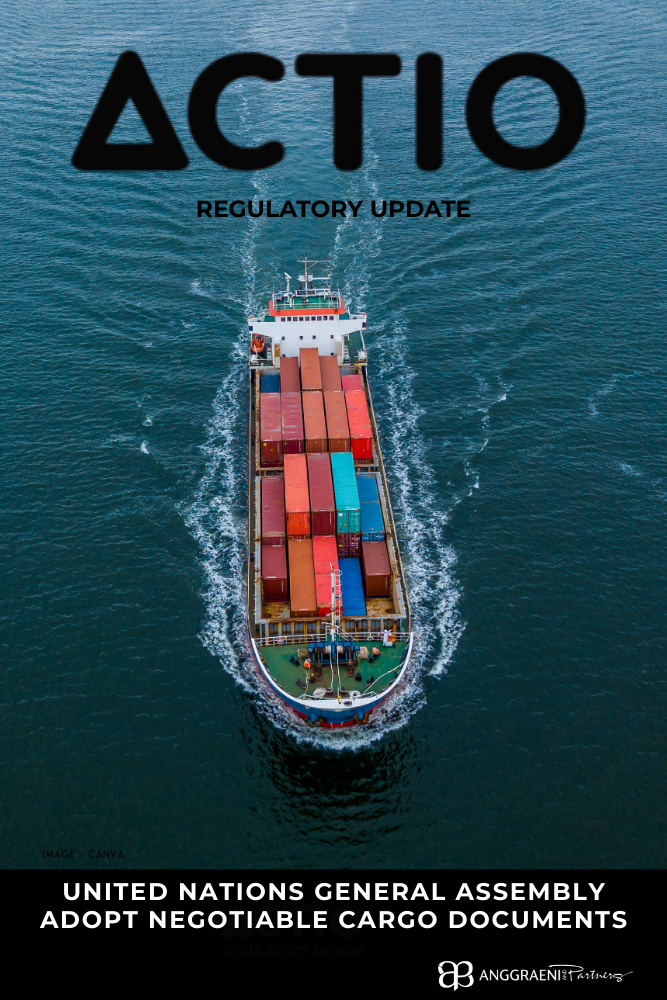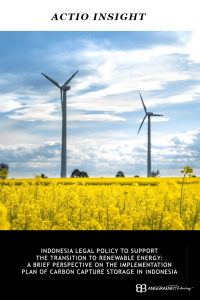Indonesia Legal Policy to Support the Transition to Renewable Energy: A Brief Perspective on the Implementation Plan of Carbon Capture Storage in Indonesia
Setyawati Fitrianggraeni and Fajrin Muflihun[1]
Keyword : legislation, arbitration, dispute resolution, corporate law, intellectual property, Carbon Capture Storage, CCS
- Introduction
Indonesia has the fourth largest human population in the world and produces vast amounts of Greenhouse Gas (“GHG”) , especially by burning fossil fuels which increase GHG emissions. This has a direct impact on climate change. Several efforts need to be made to reduce emissions from these GHGs, one of which is by utilizing Carbon Capture and Storage (“CCS”) technology.
CCS prevents large amounts of CO2 from being released into the atmosphere. This technology includes capturing the CO2 produced by large industrial plants, compressing it for transport, and then carefully loading it into very deep rock formations, where it is in permanent storage (Global CCS Institute). Through this technology, the release of GHG emissions resulting from the use of fossil materials in industry by large-scale power plants can be mitigated. There are three main processes in CCS, namely:[2]
- Capture
Capture refers to the preliminary phase of separating CO2 from the fuel or the fuel gases of combustion. The captured CO2 is subsequently compressed into a liquid or supercritical fluid, making it suitable for shipment. The capture phase is the most expensive phase of CCS, hence there is a strong push to develop technology that can lower costs. There are a variety of capture methods in use, all of which are proven successful, but are used differently depending on the source of emissions.
- Transport
CO2 is compressed for shipment after separation. In the majority of instances, a CO2 capture facility may not be positioned close to a suitable CO2 storage site. Consequently, CO2 must be transferred, often via dedicated pipelines. Transporting CO2 to storage sites has also been proposed through barging and shipping. In the oil and gas sector, CO2 is often transported through dedicated pipelines to assist EOR operations.
- Storage
The gas is compressed to a level in which its density is comparable to that of water. The supercritical CO2 is subsequently injected into a sedimentary basin, where it will be stored indefinitely. These basins must be permeable and porous, allowing for the storage of huge quantities of CO2. This also promotes the spreading of the injected CO2 throughout the rock formation. On top of the porous rock, a cap rock (or barrier layer) is required to capture the injected CO2.
CCS is currently employed worldwide. There are already 29 operational plants with a total capture capacity of almost 40 million tonnes per year, which is comparable to removing nearly 8 million cars off the road. There are already approximately 100 facilities in different phases of development and in a variety of industries, but much more must be done.[3]
- CCS in Indonesia
As a sign of its commitment to lowering greenhouse gas emissions, the Indonesian government recently increased its greenhouse gas emission reduction target. In Indonesia’s latest Enhanced Nationally Determined Contribution (ENDC) document, RI raised its emission reduction target from 29% to 31.89% in 2030 through its own capabilities. Meanwhile, the target for reducing greenhouse gas emissions from international cooperation was also increased from 41% to 43.2%.[4]
Indonesia has many oil and gas fields with high CO2 content. Currently, there are 15 CCS/Carbon Capture Utilization Storage (“CCUS”) activities in Indonesia that are still in the study/preparation stage, however the majority are expected to be operational by 2030. Juniarto M. Palilu from the Directorate General of Oil and Gas also conveyed the importance of ensuring that CCS/CCUS activities do not leak so that CO2 is injected and can be stored safely and permanently. To encourage the use of CCS/CCUS in oil and gas business operations, the government has drafted regulations that involve various stakeholders and are anticipated to be finalized in the near future, he stated.[5]
In addition, efforts to reduce carbon emissions by using CCS are also carried out by PT Pertamina (Persero). PT Pertamina (Persero) is committed to reducing the level of carbon emissions in several of its oil and gas projects. One example is a company that will apply technology to reduce carbon emissions through Carbon Capture Storage (CCS)/Carbon Capture Utilization and Storage (CCUS). Pertamina Senior Vice President Research & Technology Innovation Oki Muraza revealed that PT Pertamina (Persero) will work on six CCS/CCUS projects in the decarbonization step.[6]
- Regulation related to CCS in Indonesia
Indonesia commitment to achieve Net Zero Emission is reflected in the National Energy Policy. The National Energy Policy is based on Indonesia execution of the 2016 Paris Agreement as ratified by Law Number 16 of 2016 concerning ratification of the Paris Agreement to the United Nations Framework Convention on Climate Change. Government Regulation Number 79 of 2014 concerning National Energy Policy is part of Indonesia’s domestic law.
As explained above, the Government contributes to reducing the greenhouse gas effect and achieve Net Zero Emissions by 2060 is to carry out carbon capture storage (“CCS”). The Government of Indonesia has issued Presidential Regulation No. 98 of 2021 concerning the Economic Value of Carbon (“Presidential Regulation on the Economic Value of Carbon Economy”) which also regulates the carbon market. In the Presidential Regulation on the Economic Value of Carbon, several carbon trading mechanisms are regulated, namely trade between two business actors through a cap-and-trade scheme, emission development through a carbon offset scheme, performance-based payments, and levies on carbon, including storage/strengthening of carbon reserves.[7]
Furthermore, the Government of Indonesia is drafting regulations to accelerate the implementation of CCS projects, provide transparent mechanisms to ensure the safety of operations, and promote sustainable CCS projects. The regulations of the Ministry of Energy and Mineral Resources (MEMR) on CCS will mainly deal with the rights of contractors to implement CCS in their work areas.[8]
During the drafting of CCS regulations, the Government of Indonesia invited public participation from local and international parties such as oil companies and industries. Most have expressed appreciation of the content of the regulations covering the most important CCS issues. It bears noting that there existing regulations regarding the CCS, in particular, Presidential Regulation on the Economic Value of Carbon Economy. However, the realization of carbon trading will need specific carbon trading regulations, which are still under consideration and drafting.
Other than regulations, CCS technology involves large investment costs. Government’s support in the form of incentives and subsidies is also needed. Some incentives that may be considered by the Government for stakeholders may include (a) Tax and customs reduction for oil and gas projects that use CCS in upstream oil and gas; (b) Ease of bureaucracy and licensing for the implementation of CCS; or (c) Credit tax subsidies to oil and gas contractors that manage to store or capture CO2.
Based on the above, the Government of Indonesia appears to be lending full support to achieve a sustainable energy sector. Through regulations and fiscal incentives, it is hoped that CCS will grow and attract investments in Indonesia to ensure environmental preservation for future gen
- Setyawati Fitrianggraeni is Managing Partner at Anggraeni and Partners, Indonesia, Assistant Professor at the Faculty of Law University of Indonesia, and PhD Candidate at the World Maritime University, Malmo, Sweden
[2] Indonesia Center of excellence for CCS and CCUS. “Carbon Capture and Storage (CCS),” Accessed January 22, 2023, https://ccs-coe.fttm.itb.ac.id/whats-ccs/carbon-capture-and-storage-ccs/.
[3] Global CCS Institute. “CCS Explained: The Basics.” Accessed January 23, 2023. https://www.globalccsinstitute.com/resources/ccs-101-the-basics/
[4] Annur, Cindy Mutia . “Indonesia Naikkan Target Penurunan Emisi Gas Rumah Kaca Jadi 31,89% Pada 2030.” Databoks. Accessed January 22, 2023. https://databoks.katadata.co.id/datapublish/2022/11/10/indonesia-naikkan-target-penurunan-emisi-gas-rumah-kaca-jadi-3189-pada-2030.
[5] Direktorat Jenderal Minyak dan Gas Bumi, Kementerian ESDM. “Teknologi CCS-CCUS Jadi Tren Baru Hadapi Transisi Energi.” Accessed January 22, 2023. https://migas.esdm.go.id/post/read/teknologi-ccs-ccus-jadi-tren-baru-hadapi-transisi-energi.
[6] Andrianto, Robertus. “Tekan Emisi Karbon, Pertamina Bakal Garap 6 Proyek CCS/CCUS.” CNBC Indonesia. Accessed January 22, 2023. https://www.cnbcindonesia.com/news/20220829190828-4-367550/tekan-emisi-karbon-pertamina-bakal-garap-6-proyek-ccs-ccus.
[7] http://ppid.menlhk.go.id/berita/siaran-pers/6269/perpres-nilai-ekonomi-karbon-dukung-pencapaian-ndc-indonesia
[8] https://www.asiaccusnetwork-eria.org/news-updates/indonesia-drafting-ccs-and-ccus-regulation-to-accelerate-ccs-and-ccus-projects-execution
——————————————————————————————————————————————————
DISCLAIMER
The information contained in this Legal Insight is not intended to provide legal opinion or views of the Anggraeni and Partners law offices against a particular legal issue.
Neither party may assume that he or she should act or cease to act or choose to act on a particular matter based on this information without seeking advice from professionals in the field of law in accordance with certain facts and circumstances it faces.
For further information, please contact:
P: 6221. 7278 7678, 72795001
H: +62 811 8800 427
S.F. Anggraeni
Managing Partner
fitri@ap-IawsoIution.net
Download PDF




